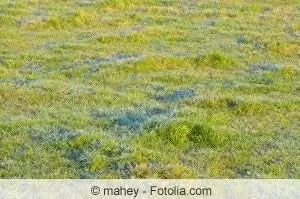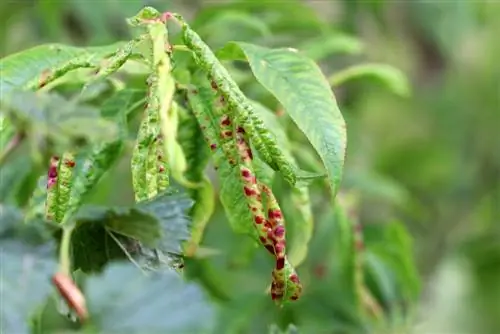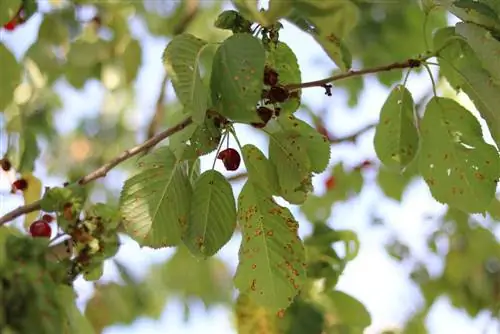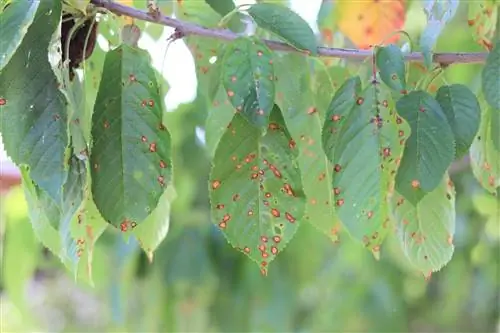- Author admin [email protected].
- Public 2023-12-17 03:39.
- Last modified 2025-01-24 12:45.
The dollar spot disease has the scientific name Sclerotinia homoeocarpa and attacks lawns from spring to late summer/beginning of autumn because they prefer warm temperatures. Only the leaves of the grass are affected by the fungal pathogen; clear, straw-like spots form, which are initially about the size of a coin.
The causes are soil that is too moist and poorly ventilated, long-term high humidity and a lack of nitrogen and potassium. With suitable preventive and countermeasures, dollar spot disease can be combated sustainably, even without chemical agents.
Causes
With dollar spot disease, lawns are infected with the harmful fungal pathogen Sclerotinia homoeocarpa, primarily during warm summer months. Especially on deep-cut lawns used for sport, for example on golf courses or football fields, the fungal disease has an extremely negative impact on the quality of the lawn. If the weather conditions are right and the grass is constantly moist, the fungus grows out with the mycelium and attacks new and he althy growing leaf tissue. This uses existing wounds and stomata on the grass, and in severely weakened lawns the fungus can grow directly through the epidermis into the leaf tissue. The following criteria in particular promote the infestation of dollar spot disease:
- permanently moist and poorly ventilated soil
- long-lasting high temperatures (25-30 °C), with cool and dewy nights
- severely dried out soils, which are subsequently watered excessively
- extremely high humidity
- Lack of nitrogen and potassium
- Fungus survives as mycelium in infected grasses
Tip:
The fungal disease spreads through mycelium spread on equipment, shoes and even through animals. Therefore, if an infection is suspected, dogs should no longer be allowed to run freely across the lawn.
Symptoms & damage
Characteristic of dollar spot disease is the damage that gives it its name, which is caused by a fungal pathogen. Based on the cutting height of the lawn, round, coin-shaped spots initially form that are sharply separated from the he althy lawn area. The following aspects are significant in terms of the symptoms and the damage:
- Infestation period from May/June to September/October
- Whitens the leaves of the grass, but does not affect the roots of the grass
- At the beginning of the fungal infection, individual and yellowish spots of around 1-2 cm appear
- Diameter can increase to up to 5-15 cm as the disease progresses
- With very high humidity and increased dew, whitish mycelium forms
- Mycelial parts are active particles of the fungal pathogen, also called aerial mycelium
- Dead grasses become yellow and strawy
Tip:
As the cutting height increases, the spots grow, so the lawn should not be allowed to grow too high or too wild. In this way, any infestation can be identified much more quickly.
Preventive measures
Since the fungal pathogen that causes dollar spot disease is increasingly showing resistance to the commonly used fungicides from specialist retailers, it is becoming increasingly difficult to combat after an outbreak. For this reason, it is better and more effective to avoid the fungus with appropriate preventive measures than to treat it afterwards with chemical weapons. The following preventative measures make the pathogen Sclerotinia homoeocarpa harmless:
- balanced supply of nutrients and fertilizers
- additional administration of potassium at the beginning of summer
- Potassium increases the resistance of the epidermis and the stress tolerance of the grass
- avoid prolonged drying out of the lawn and soil
- water correctly, heavy watering before the midday heat in the early morning hours
- Promoting air circulation in the lawn
- Quickly remove morning dew
- check regularly for thatch
- Remove matted lawns promptly, scarify the lawn regularly
- Increase floor ventilation
- Slit the lawn periodically and then aerate it, then sand it
- When growing, prefer resistant grass varieties, for example bentgrass
- observe strict hygiene regulations
- Avoid transmission with devices and through shoes
- Clean all used items very carefully after use
Countermeasures
If only a few parts of the lawn are affected by dollar spot disease, there is still scope for natural countermeasures:
- Remove large areas of affected lawns
- aerate the entire lawn
- set a higher cutting height when cutting lawn
- if there is a lack of nitrogen and potassium, fertilize until the end of July
- However, do not apply fertilizer later, excessive growth promotes the disease
- Strictly avoid entering already diseased areas on he althy lawns
- Optimize already infested areas regularly by reseeding with resistant grass varieties
Combat with chemicals
If the dollar spot disease is already well advanced and has affected large parts of the lawn, often only the use of chemical agents intended for this purpose helps. These are usually offered in a well-stocked hardware store or in a specialist garden store. However, the chemical agents should really only be used in emergencies and should under no circumstances be used regularly, otherwise the lawn will build up resistance to them. The following active ingredients are suitable for actively combating dollar spot disease:
- Carbendazim
- Chlorothalonil
- Iprodione
- Propiconazole
- Pyraclostrobin
- Thiophanate-Methyl
Conclusion of the editors
Dollar spot disease is a nuisance and can quickly ruin a lush green lawn with unsightly and strawy spots. Therefore, regular checks on the lawn during the warm summer months are extremely important, as is constant care during this period. With adequate ventilation and sustainable fertilization, the immune system of the lawn is strengthened and infection is prevented in advance. Increased potassium and nitrogen doses in spring and scarifying the lawn strengthen the resistance and prevent the transmission of the fungal pathogen. In addition, strict hygiene regulations prevent the transmission of dollar spot disease; all used equipment and footwear must always be cleaned after use. However, if the infestation has already spread very widely, only chemical products from specialist retailers can help in hard cases.
What you should know about dollar spot disease in brief
How to recognize dollar spots in the lawn
- The damage pattern varies depending on the growth height of the lawn, with strawy spots, usually in a round shape, forming on the lawn.
- If your lawn is cut particularly flat, you will recognize dollar spot disease as spots about the size of a coin.
- The higher the height of the lawn, the larger the spots become, which can even work their way up to a spot size of 15 cm each.
- Another feature: discoloration, where you can see delicate depressions in the form of a white web-like network.
- Usually only certain types of lawn are affected: bentgrass types, annual panicle and red fescue types.
Infestation and control
- The pathogen prefers higher temperatures between 25 and 30 °C.
- Wet nights and increased soil drying lead to potassium and nitrogen deficiencies in grasses.
- It can also affect your lawn between the end of May and the beginning of October.
If this is the case, you must act quickly: Make sure that you do not spread the disease to he althy lawns. This means you have to clean your garden tools thoroughly and remove all grass residue. Stepping from diseased areas onto he althy lawns should also be strictly avoided. Combat the Causes of Dollar Spot Disease:
- You can initially give the lawn a higher cutting height and ensure sufficient air circulation.
- Use chemical agents intended for this disease, which are available at hardware stores or garden centers.
- Use this only in an emergency and definitely not regularly!
- Provide the soil with sufficient nutrients and provide the affected areas with new seeds of a more resilient type of lawn.
Prevention
- You can, for example, ensure that the soil does not dry out too much
- and that you are more likely to water the lawn in the morning hours.
- Additional administration of potassium in spring can also strengthen the lawn.






